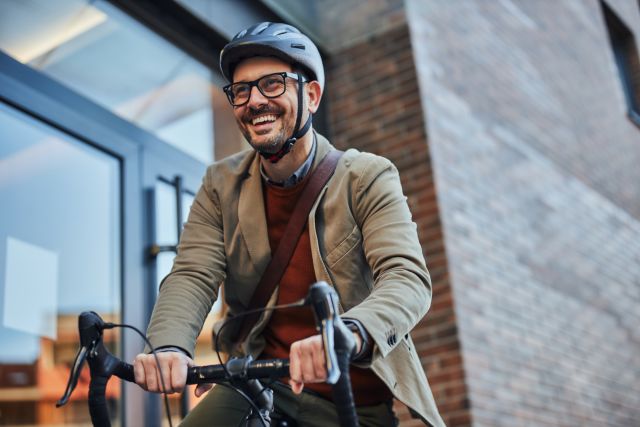Updated on March 8, 2023.
Recently I chatted with a childhood friend about the crazy, unsafe things we did on bicycles when we were young. Whether it was launching ourselves off homemade ramps, towing our friends on skateboards, or riding on handlebars, we did most of it without helmets.
These days, I'm pretty serious about safety when I'm on a bicycle. I follow the law, I pay close attention to my environment, and I always wear a helmet—even if I'm just going for a leisurely spin around the neighborhood.
That last policy probably saved my life. In April 2012, I hit an obstruction in the road and landed on my head. I broke five bones in my face; the surgeons used three titanium plates and a dozen screws to put me back together. (And no, they don't set off the metal detectors at the airport.)
The injuries were serious enough, but my helmet probably kept me alive. The portion that covers the upper part of my forehead was smashed into pieces.
May is National Bike Month, and Bike to Work Day is typically held in the spring. There are many reasons to get on your bike and celebrate these events, among them: Commuting on a bike can save money and time. Riding a bike is good for the environment. And cycling is great exercise.
Whether you ride all the time or haven't cycled in a while, here are five tips to help you ride safely.
1. Wear a helmet and make sure it fits properly.
Recently I caught myself yelling at a restaurant delivery person who, like many in the area of Atlanta where I work, wasn’t wearing a helmet. As he wove through traffic, hopped a curb, and deftly ran a red light, I wondered just how hard his head was. I bet the concrete was harder.
Bicycle helmet usage estimates vary widely, but it’s likely around 50 percent of all cyclists, according to reports. That’s not nearly enough. (By comparison, nearly 92 percent of people wear seat belts.)
Cyclists accounted for 2 percent of all fatalities involving motor vehicles in 2019, according to the National Highway Transportation Safety Administration (NHTSA). Many more people end up in the emergency room after crashes not involving cars. Bicycle injuries are the number one reason kids visit the emergency department for nonfatal traumatic brain injuries.
2. Share the road.
This is the battle cry of many cyclists, but it goes both ways. I see a lot of cyclists with poor road etiquette. They hop curbs, run lights, travel in the left lane, or fail to signal. They’re a danger to themselves and to motorists. If you’re going to commute to work or ride in traffic, give cars a wide berth. If cyclists expect motorists to share the road, they should, too.
3. Join a group ride.
There is safety in numbers. Many urban bike shops sponsor rides during the week, and bicycle clubs offer regular weekend treks. Where I live, these rides are usually on established routes that have less traffic. And other riders are familiar with the roads and hazards. Plus, the sponsoring groups tend to enforce safety protocols.
In a number of cities, bicycling organizations are organizing group cycling commutes and other rides to celebrate National Bike Month. Get on a bike and join them. Just remember to follow the rules of the road, and don’t forget to wear your helmet.
4. Pedal defensively.
Whether you’re headed to work or out for a leisurely ride, always be focused and alert to your surroundings. Attempting to anticipate what motor vehicle drivers do just might save your life. According to the NHTSA, the biggest factor in fatal bike crashes is failing to yield the right of way. Never assume that other people on the road can see you. And just like when driving a car, you shouldn’t play with your phone while riding your bike.
To make yourself more visible on the road during the day, wear brightly colored gear. At night, opt for reflective clothing and use reflectors on your bike itself. Try lights, too—a white light in the front, and a red light in the rear.
5. Realize that headphones may pose a risk.
You may want to turn the music down. A Dutch survey of over 2,000 cyclists published in Accident Analysis & Prevention in 2017 found that they reported reduced perception of traffic sounds while listening to headphones, though it wasn’t tied to the number of accidents reported. The researchers note however, that the increase in electric cars, which are much quieter, may require even more careful perception when sharing the road.

